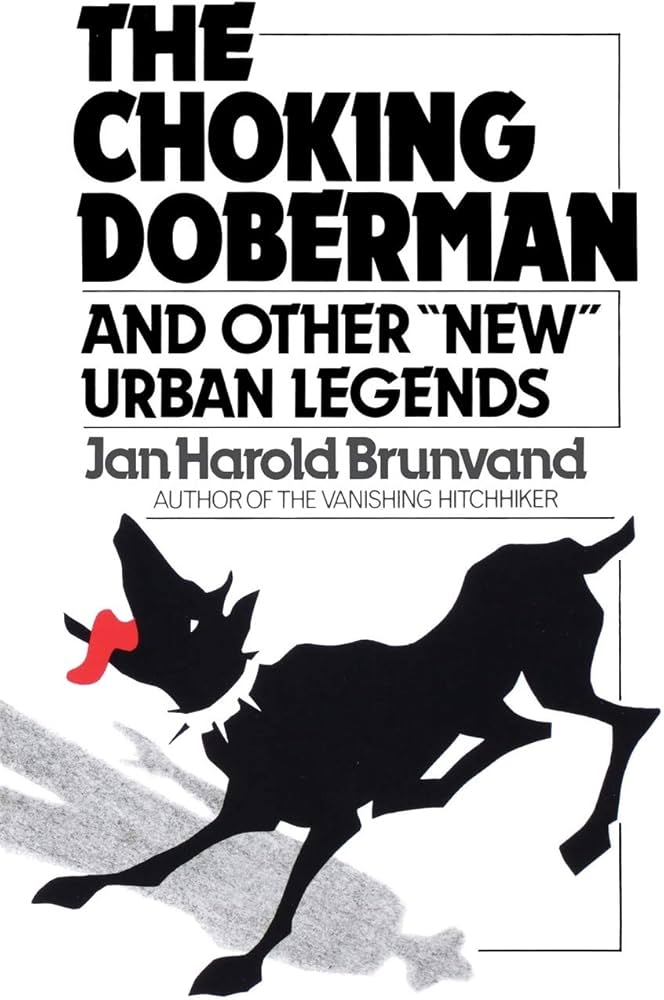The Legend’s Origins: A Tale Rooted in Fear
In the summer of 1981, an eerie tale began circulating that sent shivers down the spines of many. The story of the Choking Doberman, a dog found gasping for air with human fingers lodged in its throat, quickly became a staple of urban folklore. This legend, however, wasn’t entirely new. Similar stories had been whispered as early as the mid-1950s, but it was in the 1980s that the tale gained widespread traction. The story tapped into deep-seated fears of the time—fears of burglary, personal safety, and the vulnerability of women living alone. It was a reflection of cultural anxieties, a modern myth that spoke to the dangers lurking just outside our doors.

Image Credit: IMDb
The tale’s resurgence in the 1980s wasn’t accidental. This was a decade marked by rising crime rates and a growing sense of insecurity, particularly in urban areas. The Choking Doberman became a cautionary tale, a story that warned of the dangers of complacency. It was a narrative that played on the fear of the unknown, of intruders hiding in the shadows, waiting to strike. The legend wasn’t just about a dog choking on human fingers; it was about the fragility of our sense of security.
The Story’s Structure: A Suspenseful Narrative
The Choking Doberman follows a chillingly simple yet effective structure. A woman returns home to find her beloved Doberman struggling to breathe. Panicked, she rushes the dog to the vet, only to discover that the cause of its distress is something far more sinister: human fingers lodged in its throat. The vet, horrified, warns her to leave her house immediately, suspecting that an intruder might still be present. This twist adds a layer of suspense, turning a seemingly straightforward tale into a heart-pounding thriller.
The story’s power lies in its ability to build tension. It starts with a mundane scenario—a woman coming home to her dog—and escalates into a life-threatening situation. The discovery of the fingers is the first shock, but the real horror comes with the realization that the intruder might still be in the house. This narrative structure taps into primal fears, making the story feel all too real, even as it remains firmly in the realm of fiction.
Variations Across Time and Place
Like many urban legends, the Choking Doberman has evolved over time. In the 1980s, the dog was almost always a Doberman, a breed that was often associated with protection and loyalty. By the 1990s, however, the breed had changed, with pit bulls taking center stage as the decade’s “dangerous” dog of choice. The number of fingers found in the dog’s throat also varies, with some versions mentioning two, three, or even four fingers. These changes reflect the shifting cultural landscape, as well as the storyteller’s desire to keep the tale fresh and relevant.

Image Credit: Amazon
The locations where the story is said to have occurred also vary. While the legend is primarily associated with the United States, it has been linked to cities like Las Vegas and small towns across the country. In some versions, the intruder is discovered hiding in a closet or bedroom, while in others, he manages to escape, only to be identified later by his missing fingers. These variations highlight the adaptability of urban legends, their ability to morph and change to fit the fears and preoccupations of the time.
Cultural Significance and Misconceptions
One of the most persistent misconceptions about the Choking Doberman is that it’s based on a true story. In reality, there’s no evidence to support the claim that such an event ever occurred. From a veterinary perspective, the scenario is implausible. A choking dog would require immediate medical attention, and any vet would act swiftly to save the animal’s life. The idea that a vet would delay treatment long enough to discover human fingers is simply not realistic.
Yet, despite its fictional nature, the story continues to resonate. It serves as a cautionary tale, a reminder to stay vigilant and aware of our surroundings. The legend plays on the fear of home invasion, a fear that remains relevant even today. It’s a story that taps into our deepest anxieties, reminding us that danger can come from the most unexpected places.
The Role of Gender in the Legend
The Choking Doberman is also notable for its gendered narrative. In nearly every version of the story, the dog owner is a woman, often living alone. This reinforces traditional gender roles, portraying women as vulnerable and in need of protection. The dog, in this context, becomes a symbol of security, a loyal guardian that stands between the woman and potential harm.
This gendered dynamic is central to the story’s appeal. It reflects societal attitudes about women and safety, as well as the idea that women are more likely to be victims of crime. The story’s emphasis on the woman’s vulnerability adds an extra layer of tension, making the tale all the more gripping. It’s a narrative that plays on our fears, while also reinforcing cultural stereotypes.
Dogs as Protectors: The Instinctual Bond
At its core, the Choking Doberman is a story about the bond between humans and their dogs. The dog in the legend is more than just a pet; it’s a protector, a loyal companion willing to risk its life to defend its owner. This portrayal taps into a long-standing cultural belief in the protective nature of dogs, a belief that dates back to ancient myths and folklore.
The story also highlights the instinctual bond between dogs and their owners. Dogs are often seen as extensions of their owners, fiercely loyal and willing to go to great lengths to ensure their safety. In the Choking Doberman, this bond is put to the test, as the dog sacrifices its well-being to protect its owner from harm. It’s a testament to the enduring relationship between humans and dogs, a relationship that continues to inspire stories of loyalty and bravery.
The Choking Doberman in Popular Culture
The Choking Doberman has left its mark on popular culture, appearing in books, media, and discussions about urban legends. It’s been referenced in works by folklorists like Jan Harold Brunvand, who has written extensively about the evolution of urban myths. The story has also been adapted for humor and entertainment, with comedians and storytellers using it as a jumping-off point for their own creative interpretations.
Despite its gruesome premise, the legend has endured, becoming a modern classic in the world of urban folklore. It’s a story that continues to captivate audiences, a testament to the power of storytelling and the enduring appeal of tales that tap into our deepest fears.
The Science Behind the Myth
From a scientific perspective, the events described in the Choking Doberman are highly unlikely. The anatomy of a dog’s throat makes it improbable that a dog could choke on human fingers, especially without sustaining serious injury. Additionally, a choking dog would require immediate medical attention, making the idea of a delayed discovery of the fingers unrealistic.
This scientific perspective serves to debunk the myth, but it doesn’t diminish the story’s impact. The Choking Doberman is a work of fiction, a tale designed to entertain and terrify. Its power lies in its ability to tap into our fears, not in its adherence to scientific fact.
Fascinating Facts About the Legend
The Choking Doberman is full of intriguing details that add to its mystique. The number of fingers found in the dog’s throat varies across different versions, as does the race of the intruder in some tellings. These variations reflect the storyteller’s desire to keep the tale fresh and relevant, while also highlighting the cultural biases of the time.
The legend has also appeared in folklore collections, solidifying its status as a modern myth. It’s a story that continues to evolve, adapting to the fears and preoccupations of each new generation. Despite its fictional nature, the Choking Doberman remains a powerful reminder of the dangers that lurk just beyond our doors.
The Legend’s Legacy: A Cautionary Tale
The Choking Doberman has left a lasting legacy as a cautionary tale about home security and personal safety. It’s a story that resonates with audiences, tapping into our deepest fears and reminding us to stay vigilant. While the tale may be fictional, its message is very real: danger can come from the most unexpected places, and it’s up to us to protect ourselves and those we love.
In the end, the Choking Doberman is more than just an urban legend. It’s a reflection of our collective fears, a story that continues to captivate and terrify, even decades after it first emerged. It’s a testament to the power of storytelling, and a reminder that sometimes, the scariest stories are the ones that feel all too real.
Categories: Crime, Do you know, Folklore, Urban Legends
Tags: Choking Doberman, crime, dogs, folklore, Urban Legends
Religion: Not specified
Country of Origin: United States
Topic: Urban Legends
Ethnicity: Not specified



I don’t think the title of your article matches the content lol. Just kidding, mainly because I had some doubts after reading the article.